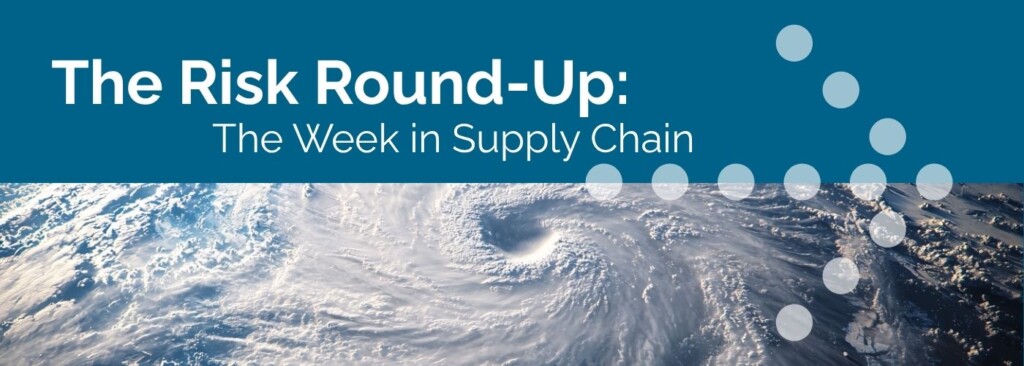
This week’s supply chain risk news
The largest earthquake since 2011 has triggered tsunami waves, evacuations, and port closures around the Pacific
A magnitude 8.8 earthquake occurred just off the east coast of Russia’s Kamchatka Peninsula on Wednesday – the most powerful since the 9.0 quake that in 2011 drove devastating waves and a nuclear disaster further south, in Japan. Dozens of aftershocks with magnitudes up to 6.9 have followed, with tsunami waves four meters high reaching Russia and tsunami advisories and evacuations extending to Japan, the Philippines, Indonesia, the U.S., Peru, Ecuador, Chile and others.
This is a developing situation with at least one known fatality, and video showed a flooded port in Russia and a building being swept away. While many of the warned countries later downgraded their alerts, port closures and cancelled flights were widespread. As we discuss in our Risk Center those include closures at multiple Japanese ports and others as far away as Los Angeles and Chile, factory disruptions in Japan, and cancelled flights in and out of Hawaii, among other potential supply chain complications.
Europe and the U.S. have reached a trade deal, but details far from clear
By now, you’ve likely seen the headlines: E.U. officials say they’ll accept a 15 percent tariff on exports to the United States. One key exception: For steel, the rate will be 50 percent. And the deal is asymmetric, meaning U.S. goods headed to countries across the Atlantic will be duty-free. But many messy details remain. It may take months to hammer out specifics concerning booze, for instance.
A particular sore spot concerns European pharmaceuticals, which the White House said this week would indeed be subject to the 15 percent tariff. Drug companies in Europe make Botox, sought-after weight-loss drugs like Ozempic, and some crucial cancer medications. Calling tariffs on medicines a “blunt instrument,” the European Federation of Pharmaceutical Industries says the move will undermine drug development, harm patients, and disrupt supply chains.
Hope is fading for a quick trade deal with India
Never say never, but with President Trump announcing a 25 percent tariff on Indian imports, it’s probably not the moment to bet on a rosy trade deal emerging imminently. Negotiations have gone on for months, touching on everything from the sale of U.S. fighter jets to relations with Russia, as well as protections for Indian farmers.
For smartphone manufacturers, and particularly Apple, the timing is awkward. Facing pressure to shift iPhone production away from China, partly to avoid tariffs, the company has been reworking its supply chains (more on tech diversification from China). As a result, an analysis out this week found by the second quarter of this year, India was outstripping China, producing some 44 percent of the smartphones sold in the U.S.
This is probably not the last time you’ll hear about White House tariff policy not meshing with Apple’s overseas production plans – or about trade negotiations between the U.S. and India. To date, there have been five rounds of talks between the two nations. A sixth is reportedly scheduled for late August.
The steaks have gotten higher
Beef prices in the U.S. are up 9 percent since the start of the year, federal officials say. If that sounds like an unhappy echo of the trend with egg prices over the last few years, there’s a twist: It’s harder to guess how soon or to what extent steak and ground beef prices will stabilize. That’s partly due to the more “fragmented and complex” nature of the beef industry, a top agriculture economist says.
Further clouding the picture is, of course, the prospect of new tariffs. On Wednesday, President Trump signed an executive order to increase tariffs on imports from Brazil to 50 percent. Brazilian beef companies had expected to sell some 400 thousand tons to the U.S. this year—by our math, that’s 3.2 billion quarter pounders. But such a tariff would, as one Brazilian beef industry official put it, render such sales “inviable.” He also says there’s no obvious alternative market to turn to with the same deep pockets or appetite for beef.
Navigating supply chain complexity with help from AI
Your organization depends on suppliers – perhaps hundreds of them. Amid the potential for fires, floods, cyberattacks, financial woes, and other disruptions, each supplier comes with some degree of risk – and each one, in turn, depends on suppliers of their own.
Monitoring all this risk, let alone quantifying it, can be monstrously complicated. It also poses a key opportunity for certain types of AI, as we discuss on our blog.
One example is mapping supplier networks. AI algorithms can help integrate details from billions of trade records, shipping manifests, corporate filings, and other data to help you connect dots and get a more coherent picture of everyone you rely on – while making sure the data included is of worthwhile quality.
AI can also serve as a digital sentinel, scanning for emerging risks in areas from weather to geopolitics to industrial accidents. Such systems can analyze millions of data points each day, distilling down the results so they’re manageable for humans.
That last part is crucial, both because even the best AI solutions hinge on human validation, and because at the end of the day, they exist to make peoples’ lives better. Until the machines take over, anyway.
